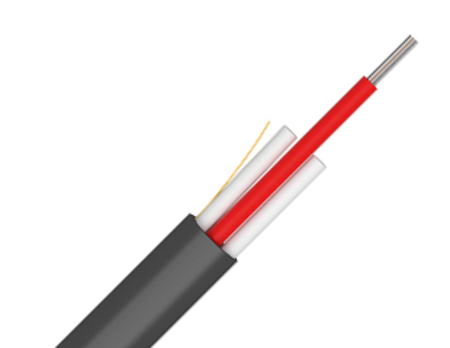Product Details
Sold in reels. Please contact us for more information.
KDP
K1FZ159024BAAA
TP023569
A-D(2ZN)2YT 2×12E9/125G.652D BLK
New
Similar Products
Product Description
The 24FO (2x12) ADSS - Aerial Loose Tube Fiber Optic Cable SM G.652.D Flat Black (Part number: K1FZ159024BAAA) from KDP with 24FO. All-dielectric self-supporting cable (ADSS) is strong enough to support itself between poles, being used in optical networks, in self supported overhead power lines, suspended on poles or mounted on buildings being the best solution for quick and low-cost installations since the poles are already mounted from legacy networks.
The 24FO (2x12) ADSS - Aerial Loose Tube Fiber Optic Cable SM G.652D Flat Black Flat from KDP is a ADSS-Aerial cable with 24 fibers within 2 loose tubes. This self-supporting flat cable for optical networks has a loose tube structure and a polyethylene sheath with incorporated non-metallic reinforcements, allowing high dielectric capability. The optical fibers comply with ITU-T recommendations G.652D.
Applications
For outdoor use; Suitable for ADSS Aerial use (self supported overhead lines) with maximum span 80 m for 1,2 sag or direct burial to sand bed.
Characteristics
- Optical fiber
- Singlemode
- Loose tube
- Dielectric
- FRP peripheral strength members
- Ripcord
- UV rays resistant
- Max. Span 80 m
- Exterior Diameter of cable 9,1x3,8 mm
- Weight 36 Kg/km
Product Specifications
Fiber Type (ITU) - OS2 G.652.D
Each type of single-mode fiber has its own area of application, and the evolution of these optical fiber specifications reflects the evolution of transmission system technology from the earliest installation of single-mode optical fiber to the present day. Choose the right fiber is very important for each project/installation. The specification of the OS2 fiber is generally considered as the SMF standard for the single-mode fiber. For the OS2 G.652 fiber there are 4 subcategories: G.652.A, G.652.B, G.652.C, G.652.D.
The OS2 G.652.D single-mode fibers are the most used type of fiber for networking and communications applications. The OS2 G.652.D fiber type provides a zero dispersion at 1310nm wavelength therefor it is optimized for operation in the 1310nm Wavelength. The regular performance remains on the 1550nm wavelength.
Benefits of using the OS2 G.652.D fibers:
- Backward compatibility with earlier versions;
- Lower system cost;
- Offers zero water peak and seamless splicing;
- Lower splicing losses;
- Supports longer cable runs.
FOC Construction - Loose tube
While using a loose tube construction in cables, you can:
- Pull and stretch without causing fractures from bending or tension;
- Have full resistant protection of the fiber core, cladding and coating (mechanical protection and UV protection);
- Reach optimized performances at extreme temperatures;
- Avoid the risk of environmental damage (including water damage).
The loose tube construction solution can be chosen for the following applications:
- Direct buried;
- Aerial;
- Duct;
- Rodent resistant;
- Indoor and outdoor;
- Water-blocking;
- Temperature endurance.
Fiber Mode - Single Mode (SM)
Single mode fiber uses a LASER light source, is a type of optical fiber with a small core diameter that allows only one mode of light to propagate. It is used in telecommunications and data transmission systems to transmit signals over long distances with low attenuation and high bandwidth. Single mode fiber is ideal for high-speed and long-distance applications, such as internet backbone networks, cable television networks, and fiber-to-the-home (FTTH) services. Its narrow core reduces the dispersion of light, allowing signals to travel further and faster than with multimode fiber.



.png?locale=en)









